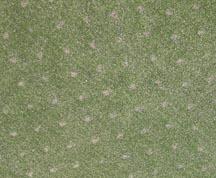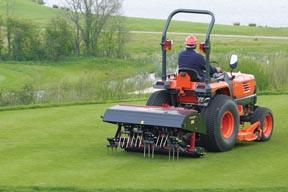Aerification is like an evil ritual at many golf courses. The superintendent knows it is necessary to do it at least once, preferably twice per year. Golfers, however, often aren't sold on its benefits or why it has to be done when grass is actively growing under non-stress conditions.
 Even with advance notice, pulling plugs often is met with resistance, and no amount of signage in the golf shop is enough to sate that golfer who misses a 4-footer on No. 18.
Even with advance notice, pulling plugs often is met with resistance, and no amount of signage in the golf shop is enough to sate that golfer who misses a 4-footer on No. 18.The recently published results of a research study conducted at Clemson University could provide superintendents with additional ammunition to communicate to golfers and committees the benefits of core aeration.
The study, conducted by Jeff Atkinson under the direction of Bert McCarty, Ph.D., and William Bridges, Ph.D., reaffirmed what superintendents already know and what many golfers do not want to hear: Core aeration reduces compaction, surface hardness and thatch levels, and improves infiltration rates and, despite initial surface disruption, it also eventually results in improved turf quality.
That might sound elementary to some, but according to the researchers at Clemson, previous work on the benefits of core aeration have focused primarily on turf quality and infiltration rates and have done little to communicate some of its other benefits. The researchers wrote: insufficient data exists on quantifying the effect of removing specific amounts of surface area per year, number of aerification events per year, or amount of topdressing applied post-aerification on turfgrass quality and soil physical properties.
The Clemson study included the effects of core aeration on soil bulk density, surface hardness and thatch accumulation.
The study examined the effects of core aeration by removing either 15 percent or 25 percent of surface matter spread over one, two or three treatments per year on a 10-year-old TifEagle plot. The plot was topdressed and rolled in two directions following each aeration.
First, the bad news. The study revealed that turf quality dropped below acceptable levels for about four weeks after each aeration procedure.
 The good news or at least some of it is that turf quality typically recovered after the first month throughout all treatments in both years of the study.
The good news or at least some of it is that turf quality typically recovered after the first month throughout all treatments in both years of the study.Fortunately for professional turf managers, the good news outweighed the bad in this study. Other findings included, not surprisingly, that removing 15 percent and 25 percent of the surface matter two or three times per year resulted in reductions in compaction, surface hardness and thatch levels as well as increased infiltration rates. Reducing the frequency of aerations to once per year resulted in improved turf quality, but did not improve soil properties the way multiple treatments did.
In both years of the study, aerifying two or three times per year reduced soil bulk density by about 5 percent compared with areas where cores were pulled one time per year.
As the number of aerification treatments increased from one to three times per year, surface hardness decreased by 4 percent in 2008 and by 19 percent the following year.
There was no significant correlation between removal of thatch and frequency of aeration in the first year of the study, but in 2009, increasing aeration events from one to three times per year resulted in a 10 percent decrease in thatch, according to research findings.
Like thatch, infiltration rate in the soil was not significantly affected the first year of the study. However, in 2009, infiltration rates were higher after aerating once compared with two or three. The researchers attributed this finding to greater fracturing of the subsoil that occurs with affecting up to 25 percent of the surface in one aeration treatment.
The researchers' final determination was that aerating multiple times per year was favorable over one treatment or not aerating at all because of the positive effects on surface hardness, removal of thatch and reduction in compaction. They also determined, however, that additional research is needed to modify timing of aeration treatments, tine size, spacing and amount of surface matter impacted to hone in on the best program.

